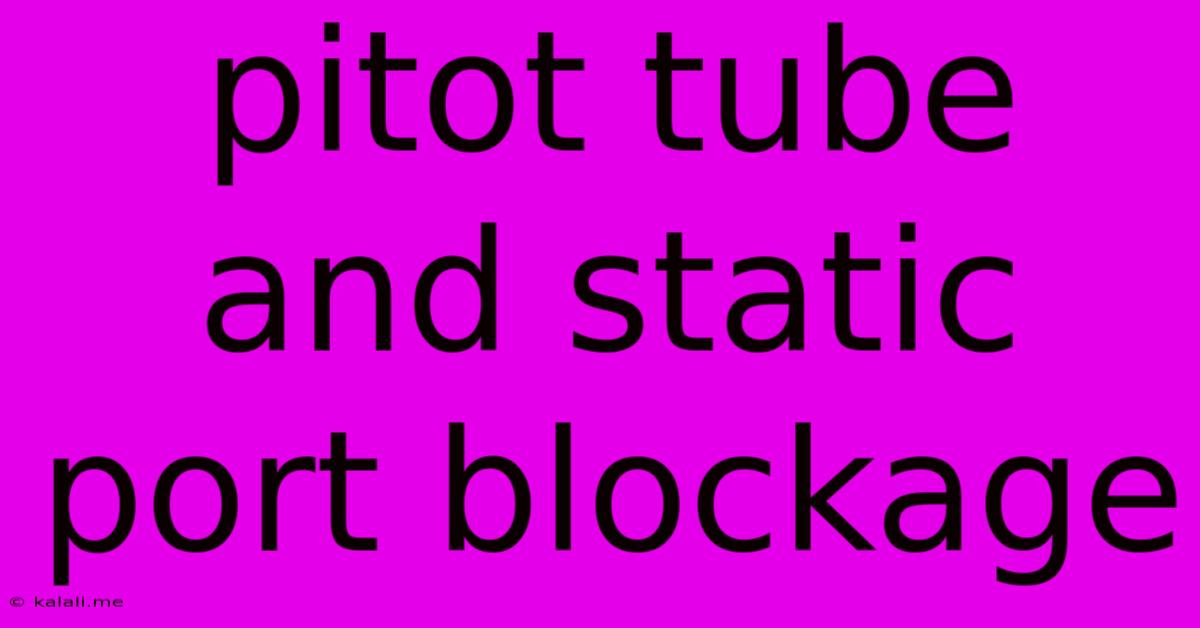Pitot Tube And Static Port Blockage
Kalali
May 30, 2025 · 3 min read

Table of Contents
Pitot Tube and Static Port Blockage: Understanding the Risks and Prevention
A blocked pitot tube or static port is a serious issue for any aircraft, potentially leading to inaccurate airspeed readings and dangerous flight situations. This article will explore the causes, consequences, and preventative measures associated with these blockages. Understanding these crucial components is paramount for safe flight operations. This guide will provide you with the knowledge to identify potential problems and ensure the reliable operation of your aircraft's airspeed indicator.
What are Pitot Tubes and Static Ports?
The pitot tube measures the total pressure (ram air pressure) of the airflow impacting the aircraft. The static port measures the ambient static pressure of the surrounding air. The difference between these two pressures is used to calculate airspeed. Both are crucial components in an aircraft's airspeed indicating system. Accurate readings from both are absolutely essential for safe and efficient flight.
Causes of Pitot Tube and Static Port Blockage
Several factors can lead to blockages in these vital components:
- Insect nests: Bees, wasps, and other insects may build nests within the pitot tube or static port, obstructing airflow. This is particularly common in aircraft stored outdoors.
- Ice formation: In icing conditions, ice accumulation can completely block the openings, leading to inaccurate or no airspeed readings. This is a major concern during flight in cold and wet environments.
- Foreign object debris (FOD): Small debris, such as leaves, dirt, or pebbles, can easily enter the tubes and ports, hindering the flow of air. This is more likely during ground operations or in dusty environments.
- Paint buildup: During maintenance, accidental paint overspray can restrict or completely block airflow. Careful maintenance procedures are crucial to prevent this.
- Bird strikes: While less common, a bird strike can potentially damage or obstruct the pitot tube or static ports. The impact might not be immediately apparent, potentially leading to delayed discovery of a critical issue.
Consequences of Blockages
Blockages in either the pitot tube or static port can have severe consequences:
- Inaccurate airspeed readings: The most immediate consequence is inaccurate airspeed readings on the instrument panel. This can lead to misjudgments regarding speed and maneuvering.
- Loss of airspeed indication: In a complete blockage, the airspeed indicator may show zero or an erratic reading, resulting in a complete loss of situational awareness regarding aircraft speed.
- Stall/spin: Without accurate airspeed information, pilots might not be able to maintain adequate airspeed, increasing the risk of a stall or spin. This is particularly dangerous at low altitudes.
- Accidents: In severe cases, inaccurate or absent airspeed information can directly contribute to accidents, potentially with fatal consequences.
Prevention and Maintenance
Regular inspection and maintenance are vital to prevent pitot tube and static port blockages:
- Pre-flight inspection: A thorough pre-flight inspection should always include a visual check of the pitot tube and static ports for any signs of blockage or damage. This should be an integral part of the pilot’s pre-flight checklist.
- Regular cleaning: Periodically clean the pitot tube and static ports using appropriate tools and procedures to remove any accumulated debris or insect nests.
- Ice protection systems: Use and regularly maintain aircraft ice protection systems (if equipped) to prevent ice buildup in icing conditions. This could include pneumatic boots or thermal anti-ice systems.
- Proper storage: Store aircraft in a clean and protected area to minimize exposure to debris and insects. Covering the aircraft can greatly reduce the likelihood of blockages.
- Maintenance schedules: Adhere to the manufacturer's recommended maintenance schedule for inspections and cleaning of the pitot-static system.
By understanding the causes, consequences, and preventative measures associated with pitot tube and static port blockages, pilots can significantly reduce the risk of accidents and maintain safe and efficient flight operations. Remember, regular inspection and diligent maintenance are crucial for the safe and reliable operation of your aircraft.
Latest Posts
Latest Posts
-
How To Change A Fraction Into A Whole Number
May 31, 2025
-
Why Is N 1 Used In Sample Variance
May 31, 2025
-
Body To Body Clearance For Smt Parts
May 31, 2025
-
How To Replace That In A Sentence
May 31, 2025
-
How To Increase The Current In A Circuit
May 31, 2025
Related Post
Thank you for visiting our website which covers about Pitot Tube And Static Port Blockage . We hope the information provided has been useful to you. Feel free to contact us if you have any questions or need further assistance. See you next time and don't miss to bookmark.